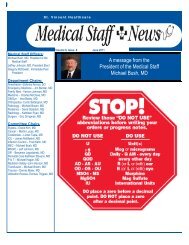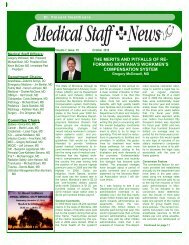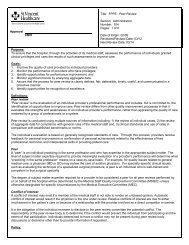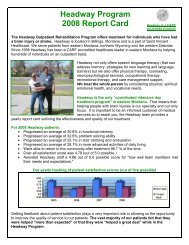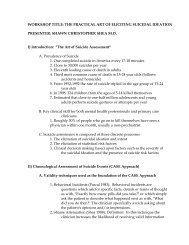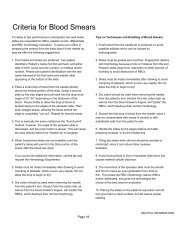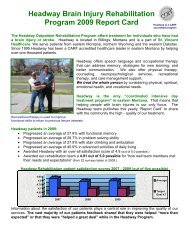AHA/ASA Guideline Guidelines for the Prevention of Stroke in ...
AHA/ASA Guideline Guidelines for the Prevention of Stroke in ...
AHA/ASA Guideline Guidelines for the Prevention of Stroke in ...
You also want an ePaper? Increase the reach of your titles
YUMPU automatically turns print PDFs into web optimized ePapers that Google loves.
242 <strong>Stroke</strong> January 2011prevention <strong>in</strong> AF patients who are allergic to aspir<strong>in</strong>. 230 TheAtrial Fibrillation Clopidogrel Trial with Irbesartan <strong>for</strong> <strong>Prevention</strong><strong>of</strong> Vascular Events (ACTIVE W) evaluated <strong>the</strong> safetyand efficacy <strong>of</strong> <strong>the</strong> comb<strong>in</strong>ation <strong>of</strong> clopidogrel and aspir<strong>in</strong>versus warfar<strong>in</strong> <strong>in</strong> AF patients with at least 1 risk factor <strong>for</strong>stroke. This study was stopped prematurely by <strong>the</strong> safetymonitor<strong>in</strong>g committee after 3371 patients were enrolledbecause <strong>of</strong> <strong>the</strong> clear superiority <strong>of</strong> warfar<strong>in</strong> (INR 2.0 to 3.0)over <strong>the</strong> antiplatelet comb<strong>in</strong>ation (RR, 1.44; 95% CI 1.18 to1.76; P0.0003). 231An additional arm <strong>of</strong> this study (ACTIVE A) comparedaspir<strong>in</strong> versus clopidogrel plus aspir<strong>in</strong> <strong>in</strong> AF patients whowere considered “unsuitable <strong>for</strong> vitam<strong>in</strong> K antagonist <strong>the</strong>rapy”and reported a reduction <strong>in</strong> <strong>the</strong> rate <strong>of</strong> stroke withclopidogrel plus aspir<strong>in</strong>. <strong>Stroke</strong> occurred <strong>in</strong> 296 patientsreceiv<strong>in</strong>g clopidogrel plus aspir<strong>in</strong> (2.4% per year) and 408patients receiv<strong>in</strong>g aspir<strong>in</strong> mono<strong>the</strong>rapy (3.3% per year; RR,0.72; 95% CI, 0.62 to 0.83; P0.001). Major bleed<strong>in</strong>goccurred <strong>in</strong> 251 patients receiv<strong>in</strong>g clopidogrel plus aspir<strong>in</strong>(2.0% per year) and <strong>in</strong> 162 patients receiv<strong>in</strong>g aspir<strong>in</strong> alone(1.3% per year; RR, 1.57; 95% CI, 1.29 to 1.92; P0.001). 232An analysis <strong>of</strong> major vascular events comb<strong>in</strong>ed with majorhemorrhage showed no difference between <strong>the</strong> 2 treatmentoptions (RR, 0.97; 95% CI, 0.89 to 1.06; P0.54). Themajority <strong>of</strong> patients enrolled <strong>in</strong> this study were deemed to beunsuitable <strong>for</strong> warfar<strong>in</strong> based on physician judgment orpatient preference; only 23% had <strong>in</strong>creased bleed<strong>in</strong>g risk or<strong>in</strong>ability to comply with monitor<strong>in</strong>g as <strong>the</strong> reason <strong>for</strong> enrollment.There<strong>for</strong>e, on <strong>the</strong> basis <strong>of</strong> uncerta<strong>in</strong>ty <strong>of</strong> how toidentify patients who are “unsuitable” <strong>for</strong> anticoagulation, aswell as <strong>the</strong> lack <strong>of</strong> benefit <strong>in</strong> <strong>the</strong> analysis <strong>of</strong> vascular eventsplus major hemorrhage, aspir<strong>in</strong> rema<strong>in</strong>s <strong>the</strong> treatment <strong>of</strong>choice <strong>for</strong> AF patients who have a clear contra<strong>in</strong>dication tovitam<strong>in</strong> K antagonist <strong>the</strong>rapy but are able to tolerate antiplatelet<strong>the</strong>rapy.The superior efficacy <strong>of</strong> anticoagulation over aspir<strong>in</strong> <strong>for</strong>stroke prevention <strong>in</strong> patients with AF and a recent TIA orm<strong>in</strong>or stroke was demonstrated <strong>in</strong> <strong>the</strong> European Atrial FibrillationTrial (EAFT). 233 There<strong>for</strong>e, unless a clear contra<strong>in</strong>dicationexists, AF patients with a recent stroke or TIA shouldreceive long-term anticoagulation ra<strong>the</strong>r than antiplatelet<strong>the</strong>rapy. There is no evidence that comb<strong>in</strong><strong>in</strong>g anticoagulationwith an antiplatelet agent reduces <strong>the</strong> risk <strong>of</strong> stroke or MIcompared with anticoagulant <strong>the</strong>rapy alone <strong>in</strong> AF patients,but <strong>the</strong>re is clear evidence <strong>of</strong> <strong>in</strong>creased bleed<strong>in</strong>g risk. 234There<strong>for</strong>e, <strong>in</strong> general, addition <strong>of</strong> aspir<strong>in</strong> to anticoagulation<strong>the</strong>rapy should be avoided <strong>in</strong> AF patients.The narrow <strong>the</strong>rapeutic marg<strong>in</strong> <strong>of</strong> warfar<strong>in</strong> <strong>in</strong> conjunctionwith numerous associated food and drug <strong>in</strong>teractions requiresfrequent INR test<strong>in</strong>g and dose adjustments. These liabilitiescontribute to significant underutilization <strong>of</strong> warfar<strong>in</strong> even <strong>in</strong>high-risk patients. There<strong>for</strong>e, alternative <strong>the</strong>rapies that areeasier to use are needed. A number <strong>of</strong> recent and ongo<strong>in</strong>gtrials are evaluat<strong>in</strong>g alternative antithrombotic strategies <strong>in</strong>AF patients, <strong>in</strong>clud<strong>in</strong>g direct thromb<strong>in</strong> <strong>in</strong>hibitors and factorXa <strong>in</strong>hibitors. To date, <strong>the</strong> most successful alternative anticoagulantevaluated is <strong>the</strong> oral antithromb<strong>in</strong> dabigatran,which was tested <strong>in</strong> <strong>the</strong> Randomized Evaluation <strong>of</strong> Long-Term Anticoagulation Therapy (RE-LY) study. 235 RE-LY, arandomized open-label trial <strong>of</strong> 18 000 AF patients, demonstratedthat at a dose <strong>of</strong> 150 mg twice daily, dabigatran wasassociated with lower rates <strong>of</strong> stroke or systemic embolismand rates <strong>of</strong> major hemorrhage similar to those <strong>of</strong> doseadjustedwarfar<strong>in</strong>. The absolute reduction <strong>in</strong> stroke or systemicembolism was small (1.69% <strong>in</strong> <strong>the</strong> warfar<strong>in</strong> groupversus 1.11% <strong>in</strong> <strong>the</strong> dabigatran 150 mg twice-daily group;RR, 0.66 [0.53 to 0.82]; P0.001). No significant safetyconcerns were noted with dabigatran o<strong>the</strong>r than a small butstatistically significant <strong>in</strong>crease <strong>in</strong> MI (0.74% per year versus0.53% per year). No recommendation will be provided <strong>for</strong>dabigatran <strong>in</strong> <strong>the</strong> current version <strong>of</strong> <strong>the</strong>se guidel<strong>in</strong>es becauseregulatory evaluation and approval has not yet occurred.However, <strong>the</strong> availability <strong>of</strong> a highly effective oral agentwithout significant drug or food <strong>in</strong>teractions that does notrequire coagulation monitor<strong>in</strong>g would represent a majoradvance <strong>for</strong> this patient population.An alternative strategy <strong>for</strong> prevent<strong>in</strong>g stroke <strong>in</strong> AF patientsis percutaneous implantation <strong>of</strong> a device to occlude <strong>the</strong> leftatrial appendage. The PROTECT AF (WATCHMAN LeftAtrial Appendage System <strong>for</strong> Embolic Protection <strong>in</strong> Patientswith Atrial Fibrillation) study demonstrated that use <strong>of</strong> anocclusion device is feasible <strong>in</strong> AF patients and has <strong>the</strong>potential to reduce stroke risk. 236 In this open-label trial, 707warfar<strong>in</strong>-eligible AF patients were randomly assigned toreceive ei<strong>the</strong>r <strong>the</strong> WATCHMAN left atrial appendage occlusiondevice (n463) or dose-adjusted warfar<strong>in</strong> (n244).Forty-five days after successful device implantation, warfar<strong>in</strong>was discont<strong>in</strong>ued. The primary efficacy rate (comb<strong>in</strong>ation <strong>of</strong>stroke, cardiovascular or unexpla<strong>in</strong>ed death, or systemicembolism) was low <strong>in</strong> both <strong>the</strong> device versus <strong>the</strong> warfar<strong>in</strong>group and satisfied <strong>the</strong> non<strong>in</strong>feriority criteria established <strong>for</strong><strong>the</strong> study. The most common periprocedural complicationwas serious pericardial effusion <strong>in</strong> 22 patients (5%; 15 weretreated with pericardiocentesis and 7 with surgery). Fivepatients (1%) had a procedure-related ischemic stroke and 3had embolization <strong>of</strong> <strong>the</strong> device. This approach is likely tohave greatest cl<strong>in</strong>ical utility <strong>for</strong> AF patients at high stroke riskwho are poor candidates <strong>for</strong> oral anticoagulation; however,more data are required <strong>in</strong> <strong>the</strong>se patient populations be<strong>for</strong>e arecommendation can be made.Available data do not show greater efficacy <strong>of</strong> <strong>the</strong> acuteadm<strong>in</strong>istration <strong>of</strong> anticoagulants over antiplatelet agents <strong>in</strong><strong>the</strong> sett<strong>in</strong>g <strong>of</strong> cardioembolic stroke. 237 More studies arerequired to clarify whe<strong>the</strong>r certa<strong>in</strong> subgroups <strong>of</strong> patients whoare perceived to be at high risk <strong>of</strong> recurrent embolism maybenefit from urgent anticoagulation (eg, AF patients <strong>for</strong>whom transesophageal echocardiography [TEE] shows a leftatrial appendage thrombus).No data are available to address <strong>the</strong> question <strong>of</strong> optimaltim<strong>in</strong>g <strong>for</strong> <strong>in</strong>itiation <strong>of</strong> oral anticoagulation <strong>in</strong> a patient withAF after a stroke or TIA. In <strong>the</strong> EAFT trial, 233 oral anticoagulationwas <strong>in</strong>itiated with<strong>in</strong> 14 days <strong>of</strong> symptom onset <strong>in</strong>about one half <strong>of</strong> patients. Patients <strong>in</strong> this trial had m<strong>in</strong>orstrokes or TIAs and AF. However, <strong>for</strong> patients with large<strong>in</strong>farcts, extensive hemorrhagic trans<strong>for</strong>mation, or uncontrolledhypertension, fur<strong>the</strong>r delays may be appropriate.For patients with AF who suffer an ischemic stroke or TIAdespite <strong>the</strong>rapeutic anticoagulation, <strong>the</strong>re are no data toDownloaded from stroke.ahajournals.org by on March 8, 2011



